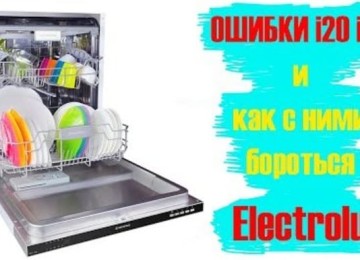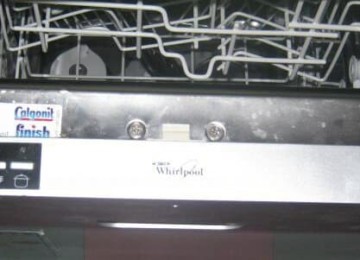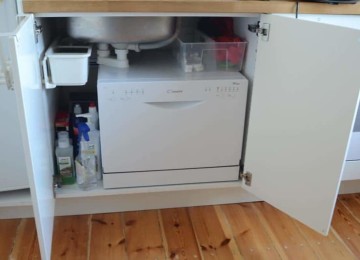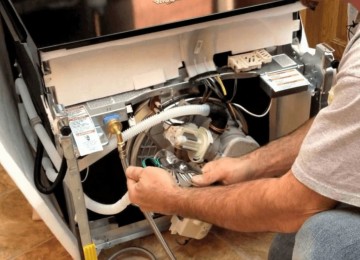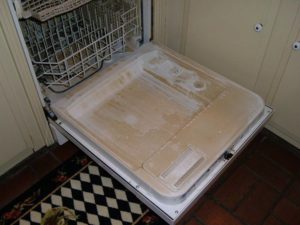 The appearance of white residue in the dishwasher is immediately cause for concern. Questions arise: “What is this? Where? Because of which?". There may be more than one reason. It is not always possible to remove plaque from a device on your own; sometimes only a service center technician can solve the problem. Of course, the operation of a dishwasher is impossible without special water softening tablets, but their use does not guarantee uninterrupted operation of the machine.
The appearance of white residue in the dishwasher is immediately cause for concern. Questions arise: “What is this? Where? Because of which?". There may be more than one reason. It is not always possible to remove plaque from a device on your own; sometimes only a service center technician can solve the problem. Of course, the operation of a dishwasher is impossible without special water softening tablets, but their use does not guarantee uninterrupted operation of the machine.
Causes of white residue in the dishwasher
The most common problem that arises during the operation of a dishwasher is a white coating on its components, and occasionally on dishes. Practice has shown that there may be several reasons:
- hardness of water;
- quantity and quality of detergents;
- technical defects or violations of operating rules.
Any of them can become the culprit in the spread of limescale.It is possible to determine what actually happened only after replacing the detergent composition and performing a set of measures to clean the household appliance.
The appearance of scale due to water hardness
Water contains a large number of impurities, a significant proportion of which are minerals. In the central water supply, the percentage of mineral salts is less than in the water supply of your own private house, where water is supplied from a deep well. Calcium and magnesium carbonates and bicarbonates are already present here, which ensures increased water hardness.
As a result, an excessive amount of hardness salts worsens the organoleptic properties of water, reduces the effectiveness of detergents, and promotes the formation of deposits and scale. Limescale deposits gradually form on the internal components of the dishwasher. An equipment malfunction occurs. Repair is a labor-intensive process, and in some cases the problem cannot be fixed. In order to avoid plaque, specialists from manufacturing companies equip their products with an ion exchanger. This dishwasher unit helps soften the water. To prevent the appearance of limescale, a special substance, resin, must be regularly added to the compartment.
Immediately after purchasing a dishwasher, you don’t have to worry about the hardness of the water; the supply of resin in the ion exchanger to soften it is enough for four cycles. Gradually this reserve decreases, each new start softens the water less, and scale begins to accumulate. The result is equipment failure.
Adding salt to the machine in a timely manner will help prevent malfunctions.
But you should always remember the dosage of the substance added for softening. Its volume depends on the degree of water hardness.For such measurements, a special examination is recommended, which requires time and money. Therefore, the best option is to buy a dishwasher that comes with a water hardness sensor. In this case, calculating the amount of substance is not difficult.
Dosage and quality of detergents used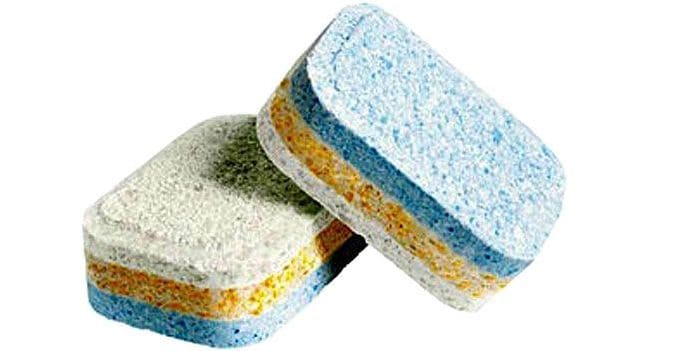
Not only hard water, but also an excess of detergents can cause a white coating. Sometimes they leave behind sediment, stains and stains. Often the cause of scale is poor rinsing, leaving powder inside. A deficiency of the product also leads to the appearance of lime on the walls of the device. Low temperature and lack of water pumped into the reservoir contribute to insufficient dissolution of the tablet, and, as a result, a white coating. In addition, excess detergent helps chemicals settle inside the machine.
Practice shows that users often pour rinse aid and powder into one tank. The consequences of this are chemical compounds on the walls of equipment and utensils. Replacing powder and rinse aid with tablets reduces the risk of scale, but does not completely protect against it.
In rare cases, a white coating may occur due to salt entering the washing tank during operation of the unit. Always ensure that the water softener compartment lid is tightly closed.
Technical malfunctions or violation of operating rules
Sometimes users encounter dishwasher breakdowns. Poor quality plugs and poorly washed tanks lead to white deposits and equipment failure.
Common malfunctions:
- The reservoir lid does not open; it is stuck. In this case, there is a high probability of some of the detergent spilling into the dishwasher compartment.Particles of the substance do not completely dissolve in water, so they settle on the walls of the equipment after rinsing.
- Filter clogged. All dishwashers are equipped with a set of filters to purify water when pumping it into and out of the compartment.
- Clogged holes in the sprayer, which leads to low pressure in the valves when pumping water.
All these problems with equipment can be corrected on your own without contacting the service department. It is recommended to disassemble the unit every six months and clean and rinse the filters, regardless of the year of manufacture and service life of the equipment. Be sure to run the machine without dishes, but with detergent. This idle start is a measure to prevent white deposits.
A tank cap failure is also a solvable problem. The spare part can be replaced or slightly sanded with a file to the required size. The breakdown occurs due to overloading the machine with dishes. Each model has its own characteristics, one of which is the permitted weight of loaded dishes. Most manufacturers, in order to prevent overload, equip the equipment with an alarm sensor that notifies when the weight is exceeded.
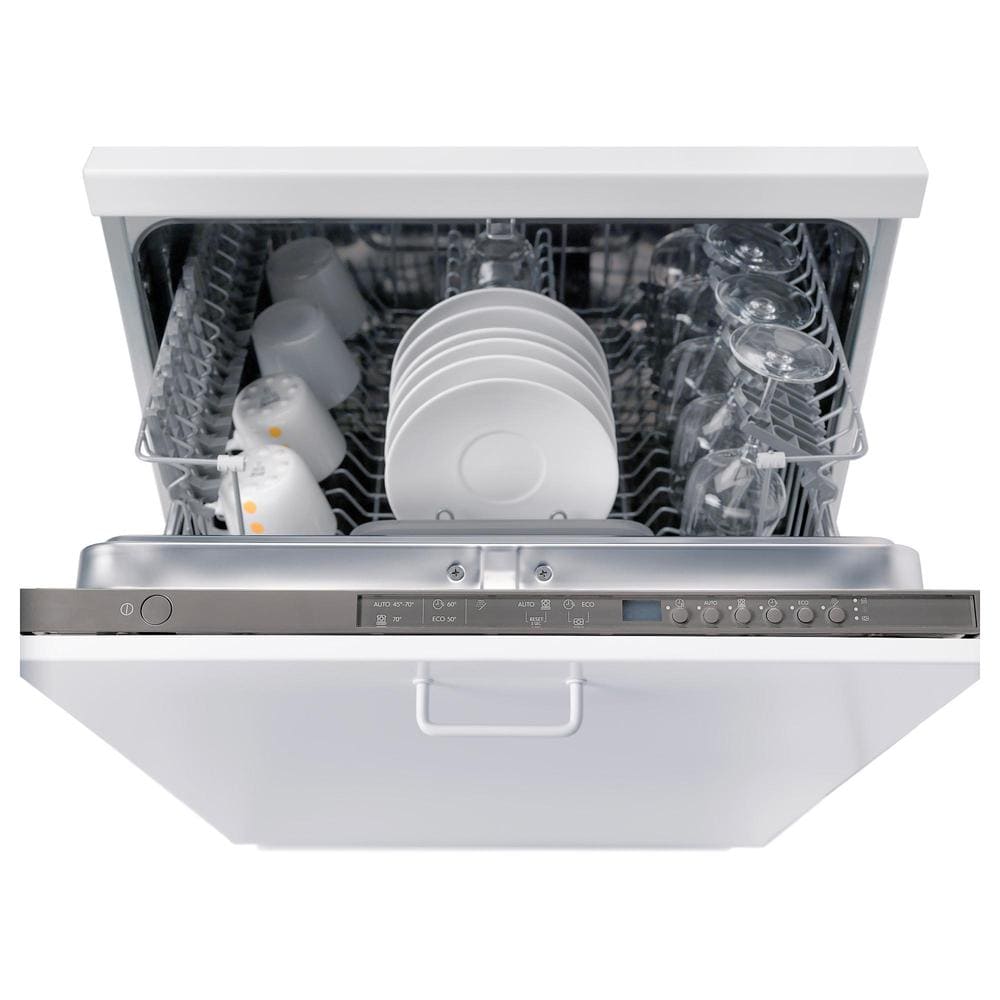
Eliminating white deposits in the dishwasher
As you know, to solve a problem, you need to know its cause. Determining the root cause of the problem will help you quickly restore the functionality of your equipment. If the malfunction is related to water hardness, then first of all you should determine the degree of hardness, how many percent it exceeds the maximum permissible level. Test strips are suitable for this.
Depending on the result, water softening agents are selected. Otherwise, limescale deposits will form inside the dishwasher, which will lead to defects and malfunctions during further operation.You cannot save on detergents; repairs will cost more. Budget substances will not completely eliminate plaque; they will leave particles on the walls of the dishwasher and dishes.
For each dishwasher model, the manufacturer has developed rules of use. Mainly, this is compliance with the volume and quantity of loaded dishes per startup of the equipment. Following the recommendations of specialists helps to increase the operating period. This is a preventative measure to prevent the appearance of white plaque.
Technical breakdowns of equipment are quickly and efficiently eliminated by service center technicians. Cleaning of spare parts, filters, and scale is an incomplete range of services provided by specialists.
Use of folk remedies
As in any other area of life, users often try to cope with the problem on their own, resorting to improvised means. The following help effectively in the fight against scale:
- lemon juice;
- Eucalyptus oil;
- several packets of citric acid;
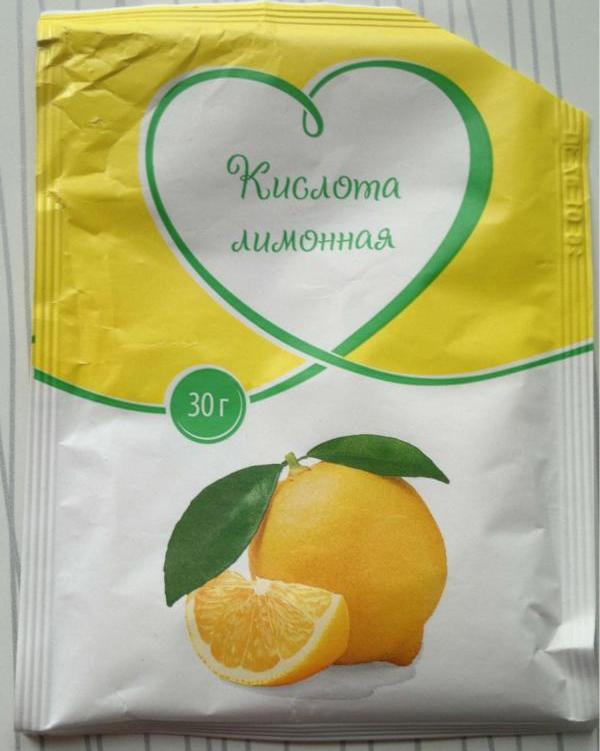
- acetic acid;
- tea tree oil.
The recipes for use are simple; they can be used either pure or diluted, in a certain ratio with water.
Removing plaque using household chemicals
Household chemicals help get rid of limescale. The assortment of modern stores allows you to choose a quality product. Practice has shown that such lines of household chemicals as “Finish”, “Somat”, “Toppe”, “Hg” are popular.
Instructions for using chemicals are the same for all manufacturers. The container with the substance is placed inside the dishwasher. The equipment is run idle twice, a program is selected with a washing duration from 45 minutes to 1.5 hours.The first start at the maximum water heating temperature cleans the insides of the equipment from scale, the second one gets rid of sediment from the chemical used.
When working with these drugs, you must follow some safety rules. The main one is protection of hands and respiratory organs. Be sure to wear rubber gloves and a medical mask. After cleaning the dishwasher, it is advisable to ventilate the room so that harmful fumes disappear.
Methods for dealing with white residue on dishes
There are many ways to counteract scale, only five are common. The first of them is changing settings. First you need to find out the water hardness indicator. At this stage, a test strip will come in handy, which may be included by the manufacturer with the dishwasher. If the device is not available, it can always be purchased in specialized stores. If this also causes a problem, you should contact the service provider responsible for the water supply of your apartment building or office. It is possible to change program settings automatically or manually.
The next method for removing plaque on dishes is the amount of salt. The algorithm of actions here is simple. It is enough to periodically check the amount of substance in the equipment tank and add the product to the amount required by the manufacturer. The salt compartment should be inspected regularly for cracks, deformation and lid closure. If a defect is detected, spare parts must be replaced.
The third way to eliminate white deposits on dishes is to comprehensively clean the equipment used. This process is labor-intensive; you need to wipe not only the walls inside the dishwasher, but also thoroughly clean the sprinklers, drain hose, lid seal and other components of the washing equipment.Filters require additional care the most. They have great difficulty getting rid of fat deposits. If funds allow, it is better to replace old parts with new ones. This method requires the use of household chemicals or folk remedies.
The fourth method is to clean one of the main components of the dishwasher - the thermoelectric heater.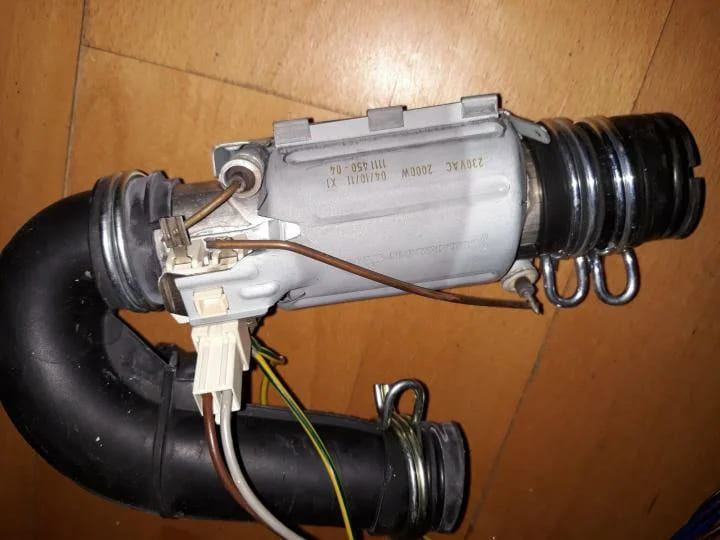 If this is not done, then equipment repair is guaranteed as soon as possible after its purchase. The frequency of this procedure is three times a year. Household chemicals, table acetic or citric acid are suitable for cleaning. The substance is poured into the powder reservoir, the equipment runs idle, and the start-up occurs without filling the container. Two cycles are enough, the duration of one is at least 45 minutes, maximum – an hour and a half. The first start is the removal of limescale, the second cycle is rinsing from chemical elements. For more thorough cleaning, it is possible to increase the operating time - program a pause.
If this is not done, then equipment repair is guaranteed as soon as possible after its purchase. The frequency of this procedure is three times a year. Household chemicals, table acetic or citric acid are suitable for cleaning. The substance is poured into the powder reservoir, the equipment runs idle, and the start-up occurs without filling the container. Two cycles are enough, the duration of one is at least 45 minutes, maximum – an hour and a half. The first start is the removal of limescale, the second cycle is rinsing from chemical elements. For more thorough cleaning, it is possible to increase the operating time - program a pause.
The fifth method of dealing with scale is assessing the quality of detergents. If sediment forms inside the dishwasher, it is advisable to immediately think about replacing the powder or tablets. If changing the detergent does not solve the problem with white residue, then the reason lies in something else - the dosage of the product. The permitted quantity is provided by the manufacturer in the operating instructions. Experts have proven that tablets, the so-called “three in one” product, are not suitable for all programmed modes of technology. They only contribute to the formation of scale.
How to prevent white residue from appearing in the dishwasher?
It is quite simple to prevent the formation of white deposits; the main thing is to use the dishwashing equipment correctly.Regular checks of the condition of the dishwasher will prevent scale build-up. It is necessary to wash the filters and periodically perform a dry start with a special product. These steps will help avoid breakdowns. For the purpose of prevention, it is advisable to inspect the tank for household chemicals and check the tight fit of the lid to the body. Preventive measures include controlling water hardness.
You should pay attention to the sensor indicators. Checking the filters and cleaning them from dirt will increase the life of the dishwasher. We should not forget about washing the equipment blades; they are removed and cleaned under running water. Use a toothpick and soap suds to clean the openings of the unit, and use a sponge or toothbrush to clean the seal. Equipment gaskets should not be washed with citric acid to avoid damaging them. Otherwise there may be a leak.
In practice, it has been found that the following actions help prevent limescale:
- adding salt or a de-hardening agent;
- use of good quality mouthwash in the recommended dosage;
- the use of tablets that completely dissolve in water and soften it;
- installation of additional filters;
- selection of dosages for dishwashing detergents;
- filling salt and rinse aid into different compartments.

General rules for caring for your dishwasher
Any technique requires constant prevention. The dishwasher is no exception. Before the first start, they analyze the water hardness, adjust the settings, and study the operating instructions. This reduces the risk of white deposits forming.
After adding salt, check the tightness of the lid and its position.Detergents must be poured into the designated compartments, observing the dosage. Using a rinse aid will eliminate the risk of covering your appliances with a white, unsightly coating.
Regularly check cleaning filters for contamination. After 4-6 months, start the dishwasher in working order on a program with the highest idle temperature. Adding vinegar or citric acid to the container instead of powder.
White deposits form on the surfaces of cookware from dirt particles. After completing the wash cycle, remove any remaining food from the filter on the bottom of the appliance.
Caring for the device and timely preventative maintenance of the dishwasher will extend the life of the kitchen appliance. By identifying and eliminating the source of the problem, you can prevent serious damage. By choosing the right products, loading and cleaning the devices according to the machine’s operating instructions, you will be able to forget about the white layers of plaque on the surfaces.
Conclusion
White deposits on the internal components of the dishwasher and dishes indicate problems with the equipment. Some users do not pay attention to this scale and continue to operate the equipment. As a result, it fails and requires replacement of expensive parts.
You must always remember that to increase the service life of equipment, you must follow basic rules of care. Timely comprehensive cleaning and the addition of high-quality detergents are a guarantee of clean dishes on the table. Water softeners prevent scale problems from occurring. Regulating their dosage will ensure clean walls and parts of the dishwasher. Cleaning your equipment every six months will get rid of grease deposits and white marks.
White streaks on dishes are an unpleasant but common occurrence. Limescale deposits are easy to get rid of. The main thing is to comply with the requirements for operating the dishwasher set out in the manufacturer's instructions.






